The Black Drongo, scientifically known as Dicrurus macrocercus, stands out as a captivating marvel of nature, particularly in the tropical regions of Asia. This bird commands attention with its striking all-black plumage and distinct forked tail.
Beyond its appearance, the Black Drongo exhibits fascinating behaviors, including its aggressive defense of nests against larger birds and its remarkable ability to mimic the calls of other species.
Found in diverse habitats, from cultivated areas to light forests, these skilled insectivores occasionally supplement their diet with berries and small reptiles.
As we delve deeper into their intriguing life, we uncover a species uniquely adapted to its environment, offering a glimpse into our planet’s rich biodiversity.
Black Drongo
The Black Drongo (Dicrurus macrocercus) is a small passerine bird native to Asia, belonging to the drongo family Dicruridae. It is renowned for its adaptability to various habitats, including urban areas, woodlands, and forests.
It is approximately 28-30 cm long and presents a striking appearance with its glossy black plumage and distinctive forked tail.
Habitat-wise, the Black Drongo thrives in open agricultural areas, light forests, and even urban environments. Its diet primarily consists of insects, although it also preys on small birds and reptiles, showcasing a diverse feeding behavior for its size.
One of the most notable features of the Black Drongo is its vocal prowess. It is a skilled mimic, capable of imitating the calls of other bird species and even mimicking predatory sounds. This behavior is believed to serve as a defense mechanism against potential threats.
While admired for its beauty and adaptability, it’s crucial to note that the Black Drongo is protected under various international wildlife laws, prohibiting its capture and trade. Therefore, it is not suitable as a pet.
Physical Characteristics of the Black Drongo
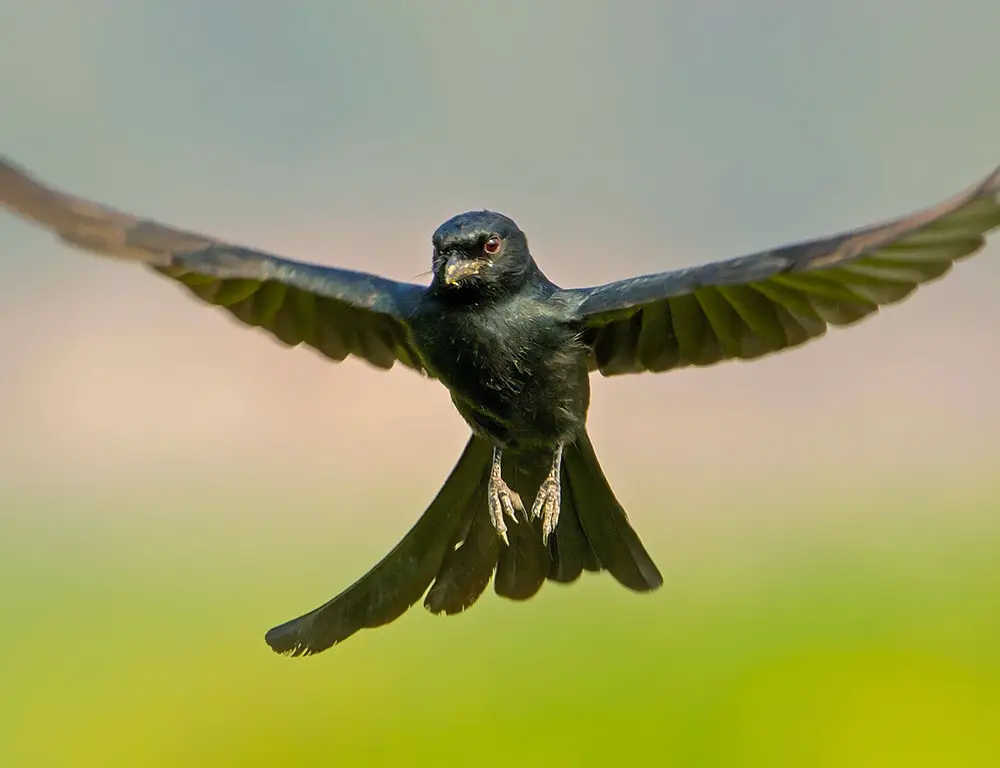
The Black Drongo possesses several distinctive physical characteristics that contribute to its unique appearance and remarkable presence:
Glossy Black Feathers
The bird’s glossy black feathers lend a sleek and sophisticated look, enhancing its overall allure. Under sunlight, these feathers exhibit an iridescent glow, adding an enchanting shimmer to their appearance.
Distinctive Shape
The Black Drongo’s body is streamlined, contributing to its aerodynamic silhouette. Its most recognizable feature is its long, deeply forked tail, which is unique to this species and serves aesthetic and functional purposes.
Red Eyes
The piercing red eyes of the Black Drongo provide a striking contrast against its dark plumage, adding to its imposing presence. These eyes are visually striking and play a role in its hunting and survival strategies.
Size and Weight
Despite its small size, typically measuring 28-30 cm in length and weighing between 33-50 grams, the Black Drongo possesses an undeniable presence. Its small yet sturdy build enables it to navigate various terrains with agility and ease.
Broad Wings
The bird’s wings are another notable feature, characterized by their breadth and sharp edge. These wings facilitate swift and precise flight, allowing the Black Drongo to maneuver effortlessly through its environment.
Specialized Bill
Equally important is the Black Drongo’s bill, which is solid and slightly curved downward at the end. This distinctive ‘hook’ shape is perfectly adapted for its insectivorous diet, enabling it to capture prey precisely.
Habitat and Distribution of the Black Drongo
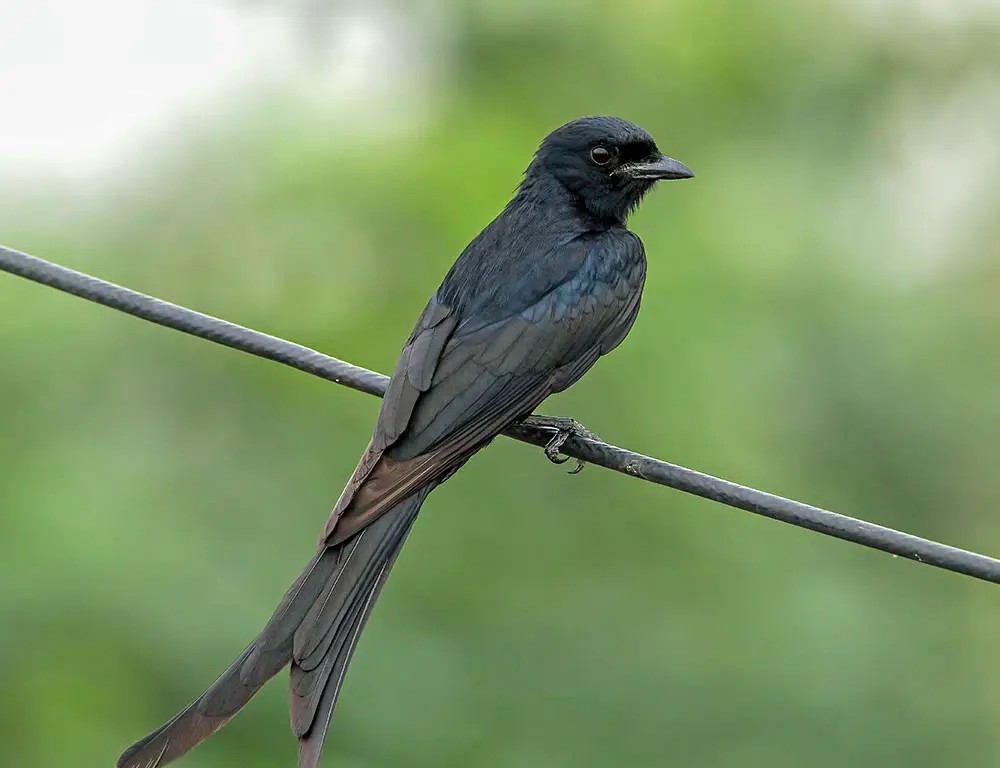
The Black Drongo’s adaptability to various habitats and its wide distribution across Asia underscore its remarkable resilience and versatility as a bird species.
Here are key points regarding its habitat and distribution:
Habitat Range
The Black Drongo is predominantly found in light forests and agricultural areas across Asia. However, it is also known to inhabit urban settlements, showcasing its ability to adapt to human-altered landscapes.
Distribution
The Black Drongo’s distribution spans a vast geographical range:
- India: It is found extensively throughout India, except in deep forest regions.
- Sri Lanka: While less common than in India, Black Drongos can still be spotted in Sri Lanka.
- China: Particularly prevalent in southern provinces such as Yunnan.
- Indonesia: Occupies regions such as Java and Bali.
- Australia: There have been recent sightings of Black Drongos migrating to parts of Australia, further expanding their distribution range.
Dietary Adaptations
The Black Drongo exhibits dietary flexibility, with its diet varying significantly depending on the region it inhabits. This adaptability, from insects to smaller birds or bats, likely contributes to its wide distribution across diverse environments.
Ability to Adjust to Human Activity
Unlike many other bird species that shy away from populated areas, Black Drongos show a remarkable ability to adapt to human activity.
They comfortably make nests around houses or fields, demonstrating resilience in adjusting to diverse environments shaped by human presence.
Versatility and Resilience
The Black Drongo’s ability to thrive across a range of habitats, from dense tropical rainforests to bustling cities, highlights its versatility and resilience as a species.
This adaptability underscores the importance of understanding habitat and distribution patterns in wildlife studies, emphasizing the need for conservation efforts to ensure their continued survival amidst changing environments.
Diet and Feeding Behavior of the Black Drongo
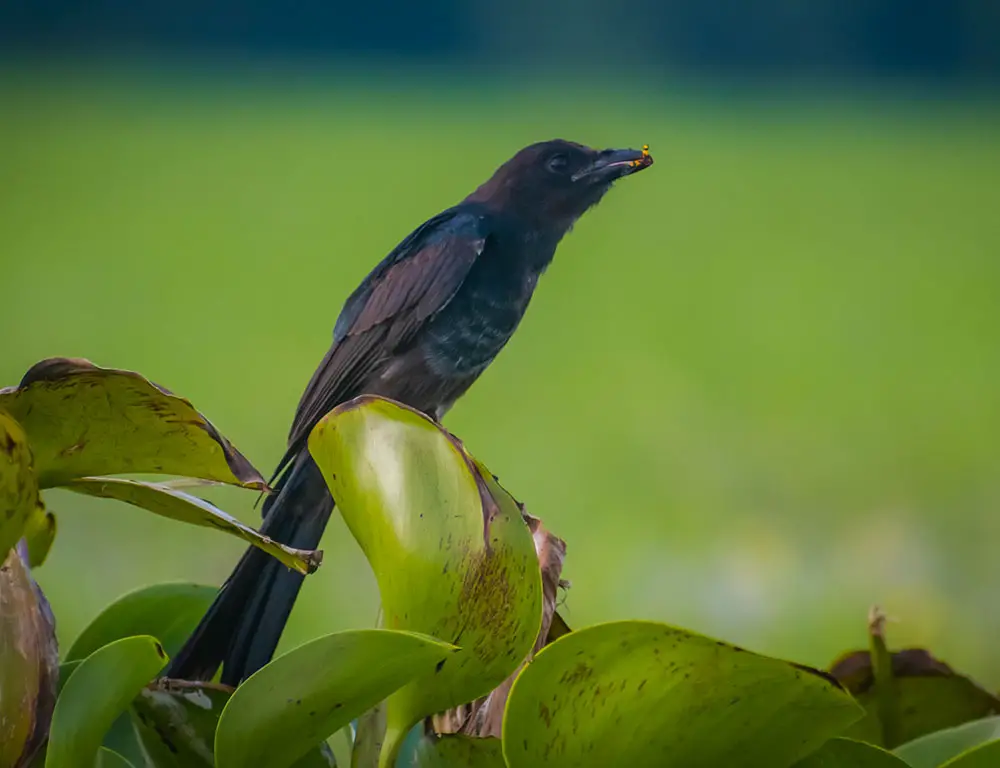
The Black Drongo exhibits intriguing dietary habits and feeding behaviors, showcasing its adaptability and intelligence as a hunter.
Here are the key points regarding its diet and feeding behavior:
Diet
Primarily insectivorous, the Black Drongo’s diet consists mainly of insects such as beetles, butterflies, locusts, and ants. However, their culinary preferences extend beyond just bugs; they also consume spiders and occasionally small reptiles or amphibians when the opportunity arises.
This dietary diversity highlights their adaptability and opportunistic feeding habits.
Feeding Behavior
The Black Drongo’s feeding behavior is characterized by its proactive hunting strategies, showcasing remarkable agility and skill:
- Perch Hunting: Positioned on elevated vantage points like trees or posts, they vigilantly scan the surroundings for potential prey, demonstrating keen observation skills.
- Aerial Hunting: When an insect flies within range, Black Drongos swiftly dive from their perches, snatching their prey mid-flight with precision and speed.
- Ground Hunting: They are not opposed to ground-level foraging, actively seeking out insects on the ground to supplement their diet.
Daily Consumption
Studies suggest that adult Black Drongos consume approximately one-third of their body weight in insects each day, highlighting their significant role in controlling insect populations within their habitat.
Breeding Season Adaptations
During the breeding season, the dietary preferences of Black Drongos undergo a shift. The increased need for protein intake, particularly for egg production, leads them to consume more small vertebrates than usual.
This adaptation underscores their ability to adjust their diet to seasonal demands, ensuring reproductive success.
Reproduction and Life Cycle of the Black Drongo
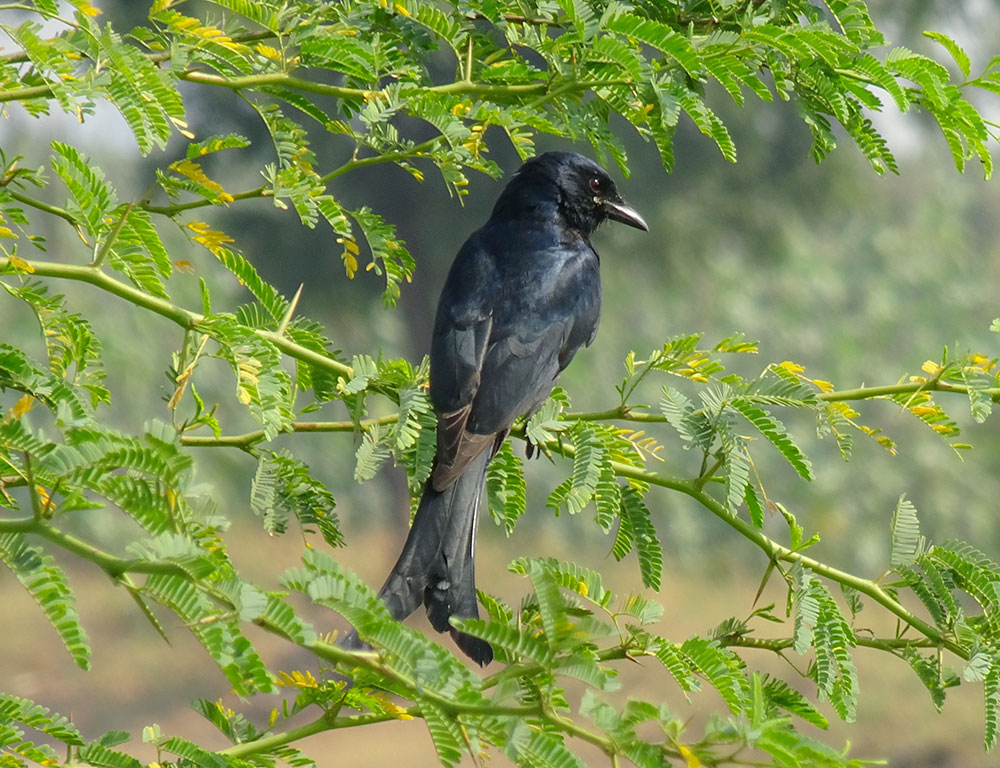
The reproduction and life cycle of the Black Drongo offer a fascinating glimpse into the intricacies of avian breeding habits and parental care.
Breeding Season
Black Drongos are seasonal breeders, typically selecting the months between May and July for nesting activities. During this time, both male and female birds engage in the laborious task of constructing nests.
Nesting Habits
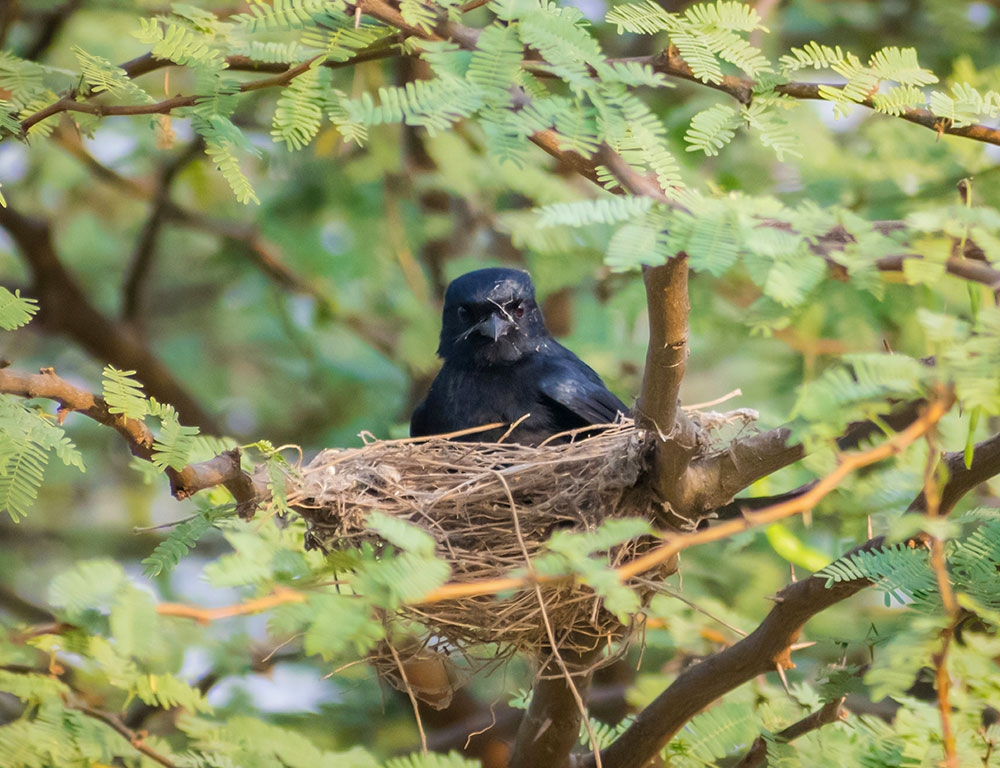
Preferred nesting sites include forked branches of trees or shrubs. Nests are constructed from twigs, rootlets, and grasses, with meticulous attention to detail to ensure resilience against harsh weather. The interiors are lined with softer materials for added comfort.
Eggs
The eggs laid by female Black Drongos are visually striking, glossy, and pale pinkish, adorned with brownish-red spots. Clutch sizes vary but typically range from 2 to 4 eggs per nest.
Incubation Period
The incubation period lasts approximately two weeks, with both parents taking turns to keep the eggs warm. This shared responsibility highlights the cooperative nature of parental care among Black Drongos.
Fledging
After hatching, the chicks remain in the nest for about three weeks before fledging occurs. During this time, parents continue to provide care and nourishment to their offspring.
Post-Fledging Care
Following fledging, parental care extends to teaching the young birds essential survival skills, such as hunting insects and recognizing potential threats. This phase lasts another few weeks until the fledglings are ready to venture out independently.
Threats and Conservation Status of the Black Drongo
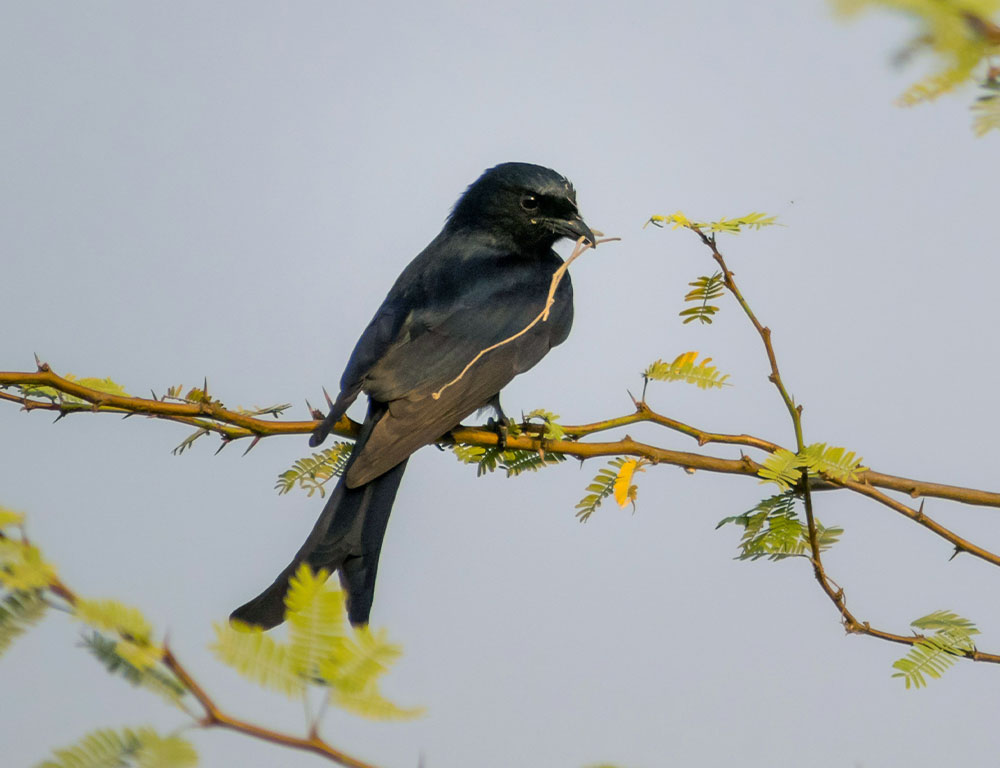
The Black Drongo, with its striking beauty and adaptability, faces several threats in its natural habitats, primarily stemming from human activities. Understanding these threats is crucial for implementing effective conservation measures to safeguard their populations.
Threats
- Habitat Loss: Deforestation and urbanization result in the loss and fragmentation of their natural habitats, reducing available nesting sites and foraging areas.
- Pollution: Pesticides used in agricultural practices pose a significant threat to Black Drongos. These chemicals can contaminate their food sources, leading to health issues and mortality within the population.
Conservation Status
The Black Drongo is currently listed as ‘Least Concern’ by the International Union for Conservation of Nature (IUCN), indicating that their population is relatively stable.
However, this status does not guarantee immunity from future threats, and continued conservation efforts are necessary to ensure their long-term survival.
Conservation Measures
- Habitat Preservation: Protecting and restoring large tracts of suitable habitat is essential for maintaining viable populations of Black Drongos. This includes conserving both forested areas and agricultural landscapes.
- Pollution Control: Implementing measures to limit pesticide use in areas where Black Drongos reside can mitigate the risks associated with pollution.
- Public Education: Increasing public awareness about the importance of Black Drongos and their conservation needs can foster support for habitat preservation and pollution control efforts. Educating communities about the value of biodiversity and the role of these birds in ecosystem health can promote coexistence and conservation.
Conclusion
The exploration of the Black Drongo’s world reveals a remarkable bird thriving in diverse environments across Asia.
Its distinctive features, fearless demeanor in defending territory, and meticulous breeding behaviors underscore its adaptability and resilience.
While currently not facing significant threats, the specter of habitat destruction looms as a potential concern for the future. As stewards of our planet’s biodiversity, we must remain vigilant and proactive in conservation efforts.
By understanding and appreciating the intricacies of the Black Drongo’s life, we recognize the importance of preserving its habitat and ensuring the continued existence of this fascinating species.
Let our journey into the realm of the Black Drongo serve as a reminder of the interconnectedness of all life forms and the collective responsibility we bear in safeguarding our natural world.